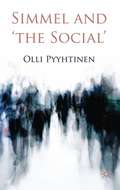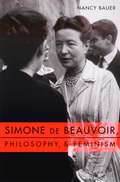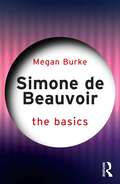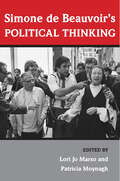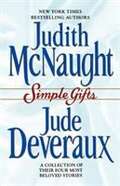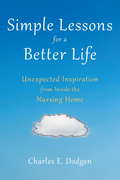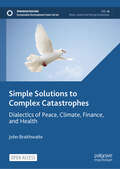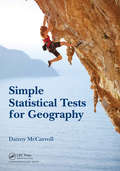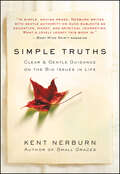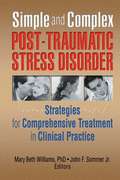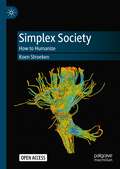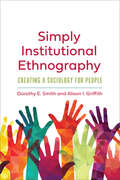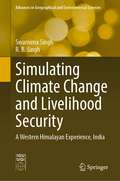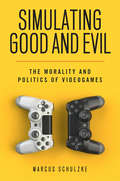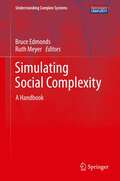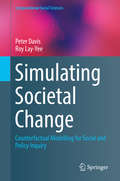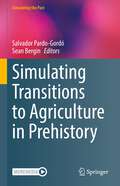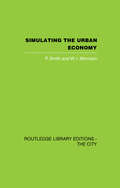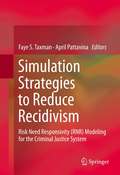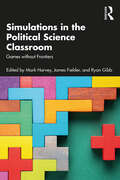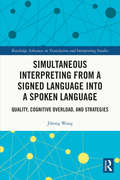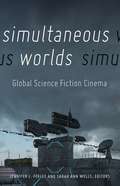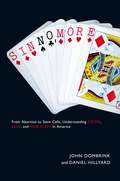- Table View
- List View
Simmel and ‘the Social’
by Olli PyyhtinenThis book argues for the centrality of Georg Simmel's social theory to the relational and processual emphases that are often considered as much more recent developments in social theory. Situating Simmel's work in particular with respect to New Vitalism and Bruno Latour's work, the book shows that Simmel has still an enormous amount to contribute.
Simone de Beauvoir, Philosophy, and Feminism (Gender and Culture Series)
by Nancy BauerIn the introduction to The Second Sex, Simone de Beauvoir notes that "a man never begins by establishing himself as an individual of a certain sex: his being a man poses no problem." Nancy Bauer begins her book by asking: "Then what kind of a problem does being a woman pose?" Bauer's aim is to show that in answering this question The Second Sex dramatizes the extent to which being a woman poses a philosophical problem. This book is a call for philosophers as well as feminists to turn, or return to, The Second Sex. Bauer shows that Beauvoir's magnum opus, written a quarter-century before the development of contemporary feminist philosophy, constitutes a meditation on the relationship between women and philosophy that remains profoundly undervalued. She argues that the extraordinary effect The Second Sex has had on women's lives, then and now, can be traced to Beauvoir's discovery of a new way to philosophize—a way grounded in her identity as a woman. In offering a new interpretation of The Second Sex, Bauer shows how philosophy can be politically productive for women while remaining genuinely philosophical.
Simone de Beauvoir: The Basics (The Basics)
by Megan BurkeSimone de Beauvoir: The Basics provides an accessible introduction to the life, work and ground-breaking ideas of author, philosopher, and feminist Simone de Beauvoir.The book offers readers “the basics” of Beauvoir, affording new and continuing readers a guide to her works and ideas. The book examines main developments in her life, the social and political events and efforts, as well as intellectual figures who influenced her thinking. Readers will be introduced to her existentialist ethics of freedom and her preoccupation with situations of oppression, covering her more widely read philosophical texts like The Second Sex and The Ethics of Ambiguity, as well as her lesser-known texts like A Very Easy Death and Les Belles Images.Simone de Beauvoir: The Basics offers an energetic introduction to Beauvoir that encourages readers to study her further and that will inspire them to think with Beauvoir in their own lives, and is of value to those studying Beauvoir’s work for the first time and those looking for a supplement to their general knowledge of Beauvoir.
Simone de Beauvoir’s Political Thinking
by Mary Caputi Karen Shelby Lori Marso Emily Zakin Sonia Kruks Patricia MoynaghBy exploring the life and work of the influential feminist thinker Simone de Beauvoir, this book shows how each of us lives within political and social structures that we can--and must--play a part in transforming. It argues that Beauvoir’s careful examination of her own existence can also be understood as a dynamic method for political thinking. As the contributors illustrate, Beauvoir's political thinking proceeds from the bottom up, using examples from individual lives as the basis for understanding and transforming our collective existence. For example, she embraced her responsibility as a French citizen as making her complicit in the French war against Algeria. Here, she sees her role as an oppressor. In other contexts, she looks to the lives of individual women, including herself, to understand the dimensions of gender inequality. This volume’s six tightly connected essays home in on the individual’s relationship to community, and how one’s freedom interacts with the freedom of other people. Here, Beauvoir is read as neither a liberal nor a communitarian. The authors focus on her call for individuals to realize their freedom while remaining consistent with ethical obligations to the community. Beauvoir's account of her own life and the lives of others is interpreted as a method to understand individuals in relations to others, and as within structures of personal, material, and political oppression. Beauvoir's political thinking makes it clear that we cannot avoid political action. To do nothing in the face of oppression denies freedom to everyone, including oneself.
Simple Gifts: Four Heartwarming Christmas Stories
by Jude Deveraux Judith McNaughtNew York Times bestselling authors Jude Deveraux and Judith McNaught shine with love's magic in this wonderful collection. Chosen from the acclaimed anthologies A Gift of Love and A Holiday of Love, these are dazzling tales to treasure time and again, stories for all seasons and for every romantic at heart.... Jude Deveraux In the snow-covered hills of Virginia, a young widow finds that miracles really do come in the least expected packages, in "Just Curious," praised as "one of Deveraux's best" (Philadelphia Inquirer). "Change of Heart," set in modern-day Colorado, is the touching story of a clever twelve-year-old who plays matchmaker for his bighearted, impractical mother. Judith McNaught This celebrated author magically portrays Regency London in "Miracles," the enchanting tale of a world-weary lord--and an outrageous proposal. In "Double Exposure," a determined young woman arrives to photograph a magnificent wedding at a reclusive tycoon's Newport estate, and manages to unlock the secrets of a man's heart.
Simple Lessons for A Better Life
by Charles E. DodgenFrom the unique experiences of nursing home residents, an empathic psychologist derives lessons for living a better life, demonstrating how people find happiness, peace, and fulfillment despite challenging circumstances. Perfect for readers who seek inspiration for living a better life at any age and who enjoy books on inspiration/motivation, wellness, psychology, self-improvement, wellness, and issues of aging. The desire to live a good life is timeless. And, sometimes, insight into what really matters emerges from where we least expect it. Even the most challenging circumstances can have a surprise silver lining. This perceptive and inspiring book shows that anyone can learn valuable life lessons from the unique experiences of nursing home residents. Using illustrative vignettes of his interactions with people facing serious physical, mental, and social challenges, the author derives twenty-eight simple, yet profoundly important, lessons for living a richer life--lessons that apply to people at any age. Dr. Dodgen, a clinical psychologist who has worked with this population for eighteen years, has discovered that when the surplus trappings of lifestyle are cleared away and lives are stripped to their most essential components, people discover new paths to happiness, peace, and fulfillment. Dodgen shares stories that demonstrate how love, meaning, purpose, and contentment can be found even in far-from-ideal circumstances. Offering deeply thoughtful reflections in an easily digestible format, this book affirms that no matter our physical, economic, or social limitations, we can remain rich in life. Readers looking for ways to improve relationships, understand and manage feelings more effectively, cope well with challenges, mitigate suffering, and discover greater serenity in their own life circumstances will find a wealth of insights in these concise, enlightening chapters.From the Trade Paperback edition.
Simple Solutions to Complex Catastrophes: Dialectics of Peace, Climate, Finance, and Health (Sustainable Development Goals Series)
by John BraithwaiteThis open access book sets out simple solutions to managing complex catastrophes. It focusses on four kinds of crises – climate change, crime-war cascades, epidemics and financial crises. These catastrophes are conceived as complex and prone to cascade effects. This book is optimistic in explaining that there are identifiable simple institutions that international society can strengthen and some simple principles that can help humankind to control the expanding gamut of complex catastrophes that confront the planet including simple, stable institutions and regulatory bodies. It draws on a wide range of current and past crises and challenges, from the Cold War to COVID-19, and from Weapons of Mass Destruction to restorative diplomacy with States like China, to provide an urgent and timely path forward. It speaks to those interested in criminology, public policy and international relations, political science, sociology, public health and economics.
Simple Statistical Tests for Geography
by Danny McCarrollThis book is aimed directly at students of geography, particularly those who lack confidence in manipulating numbers. The aim is not to teach the mathematics behind statistical tests, but to focus on the logic, so that students can choose the most appropriate tests, apply them in the most convenient way and make sense of the results. Introductory chapters explain how to use statistical methods and then the tests are arranged according to the type of data that they require. Diagrams are used to guide students toward the most appropriate tests. The focus is on nonparametric methods that make very few assumptions and are appropriate for the kinds of data that many students will collect. Parametric methods, including Student’s t-tests, correlation and regression are also covered. Although aimed directly at geography students at senior undergraduate and graduate level, this book provides an accessible introduction to a wide range of statistical methods and will be of value to students and researchers in allied disciplines including Earth and environmental science, and the social sciences.
Simple Truths: Clear & Gentle Guidance on the Big Issues in Life
by Kent NerburnSeldom does a book come along that speaks to the core issues of life with such clarity and wisdom. This profound book is deeply informed by the spiritual traditions of the West, the Far East, and the Native Americans, with whom the author has worked. It is a small treasure of wisdom about life&’s deepest issues. From the Book . . . ON EDUCATION & LEARNING The true measure of your education is not what you know, but how you share what you know with others. ON MONEY People who measure their money against their desires will never be happy, because there will always be another desire waiting to lure them. People who measure their money against their needs can gain control over their lives by gaining control over their needs. ON LOVE Love has its own time, its own season, and its own reasons for coming and going. You cannot bribe it or coerce it or reason it into staying. If it chooses to leave your heart or the heart of your lover, there is nothing you can do and nothing you should do. Be glad that it came to live for a moment in your life. If you keep your heart open, it will surely come again.
Simple and Complex Post-Traumatic Stress Disorder: Strategies for Comprehensive Treatment in Clinical Practice
by Mary Beth Williams John F Sommer Jr.Discover the latest treatment strategies from the leading experts in the field of trauma!This unique book, by the authors of the classic Handbook of Post-Traumatic Therapy, provides the “how to” of clinical practice techniques in a variety of settings with a variety of clients. Simple and Complex Post-Traumatic Stress Disorder: Strategies for Comprehensive Treatment in Clinical Practice delivers state-of-the-art techniques and information to help traumatized individuals, groups, families, and communities. From critical incident debriefing to treating combat veterans with longstanding trauma, it covers the full spectrum of PTSD clients and effective treatments. This valuable book assembles some of the most highly respected experts in trauma studies to discuss the practical applications of their research and their experience treating clients with PTSD. Simple and Complex Post-Traumatic Stress Disorder addresses concerns about the efficacy of critical incident stress debriefing, examines the value of a variety of innovative treatment methods, and explores the differences between treating complex PTSD and the aftermath of a one-time traumatic event. Simple and Complex Post-Traumatic Stress Disorder discusses the issues, stages, and modalities of PTSD treatment, including: assessment and diagnosis psychopharmacological treatment cognitive behavioral treatment short-term treatment group treatments treatment strategies for traumatized children, families, hostages, police, and veterans media issuesSimple and Complex Post-Traumatic Stress Disorder is an indispensable resource for clinicians, researchers, law enforcement officials, and scholars in the field of trauma.
Simplex Society: How to Humanize
by Koen StroekenThis open access book provides thought-provoking anthropology grounded in comparative ethnography. The theory captures the current historical moment, the long-term trends that led us here, and the prospects for a humane future. The experience of complexity characterizing a globalized information society triggers simplexes. These unidimensional responses instrumental in bringing about a predictable effect are altering our ways of communicating and the technologies we design. In Part I, a ‘speciated’ history, injected with the anthropology of Bateson and Gluckman, describes the semantic and experiential impoverishment of the lifeworld. After going through the affects of distrust (the neolithic lifeway), of futility (industrial lifeway) and disconnection (post-knowledge), the human species today depends for its survival on installing a new lifeway, which manages to wed (eco-social) inclusion to the already difficult first pair of the French Revolution. The species needs to rehumanize. Part II illustrates the remedies currently developed: to reframe, re-sphere and re-source. What do critical street art, international football matches, presidential elections, hip-hop dissing performances, charismatic church services, intuition stimulation, and ‘pre-ceptive’ experiences of consciousness have in common? They are moments of the real. Rooted in ‘life sensing’, they are tensors organizing frameshift. As multiplex measures tackling the simplex, these tensors overcome the cultural relativism of the postmodern matrix.
Simply Institutional Ethnography: Creating a Sociology for People
by Dorothy E. Smith Alison I. GriffithInstitutional ethnography (IE) originated as a feminist alternative to sociologies defining people as the objects of study. Instead, IE explores the social relations that dominate the life of the particular subject in focus. Simply Institutional Ethnography is written by two pioneers in the field and grounded in decades of ground-breaking work. Dorothy Smith and Alison Griffith lay out the basics of how institutional ethnography proceeds as a sociology. The book introduces the concepts – Discourse, Work, Text – that institutional ethnographers have found to be key ideas used to organize what they learn from the study of people’s experience. Simply Institutional Ethnography builds an ethnography that makes this material visible as coordinated sequences of social relations that reach beyond the particularities of local experience. In explicating the foundations of IE and its principal concepts, Simply Institutional Ethnography reflects on the ways in which the field may move forward.
Simulating Climate Change and Livelihood Security: A Western Himalayan Experience, India (Advances in Geographical and Environmental Sciences)
by R. B. Singh Swarnima SinghThis book identifies and provides reasoning for computed methods of local climate dynamics and the livelihood vulnerability indices assessment in the mountainous region of Himachal Pradesh, India. The outcomes of this study agree with the focused objectives on simulating climate change and its impact on livelihood security. It deals with several crucial methodologies to analyze livelihood security with and without climate change. The explorative deductive approach was used to observe climatic changes since the 1970s and simulated the climate until 2080. Additionally, the composite livelihood vulnerability index (LVI) without climate change and the climate change livelihood vulnerability index (CCLVI) with climate change impact were prepared. The book is beneficial for policymakers who are involved in framing and implementing policies chiefly in the Himalaya. It is also valuable for all stakeholders in society: students, researchers and academicians. It proposes discussions and debate on a new, integrated, inclusive and open approach to climate change and validates the significance of geographic knowledge in addressing climate change issues at various levels, suggesting policy measures to cope with them.
Simulating Good and Evil: The Morality and Politics of Videogames
by Marcus SchulzkeSimulating Good and Evil shows that the moral panic surrounding violent videogames is deeply misguided, and often politically motivated, but that games are nevertheless morally important. Simulated actions are morally defensible because they take place outside the real world and do not inflict real harms. Decades of research purporting to show that videogames are immoral has failed to produce convincing evidence of this. However, games are morally important because they simulate decisions that would have moral weight if they were set in the real world. Videogames should be seen as spaces in which players may experiment with moral reasoning strategies without taking any actions that would themselves be subject to moral evaluation. Some videogame content may be upsetting or offensive, but mere offense does not necessarily indicate a moral problem. Upsetting content is best understood by applying existing theories for evaluating political ideologies and offensive speech.
Simulating Social Complexity
by Bruce Edmonds Ruth MeyerSocial systems are among the most complex known. This poses particular problems for those who wish to understand them. The complexity often makes analytic approaches infeasible and natural language approaches inadequate for relating intricate cause and effect. However, individual- and agent-based computational approaches hold out the possibility of new and deeper understanding of such systems. Simulating Social Complexity examines all aspects of using agent- or individual-based simulation. This approach represents systems as individual elements having each their own set of differing states and internal processes. The interactions between elements in the simulation represent interactions in the target systems. What makes these elements "social" is that they are usefully interpretable as interacting elements of an observed society. In this, the focus is on human society, but can be extended to include social animals or artificial agents where such work enhances our understanding of human society. The phenomena of interest then result (emerge) from the dynamics of the interaction of social actors in an essential way and are usually not easily simplifiable by, for example, considering only representative actors. The introduction of accessible agent-based modelling allows the representation of social complexity in a more natural and direct manner than previous techniques. In particular, it is no longer necessary to distort a model with the introduction of overly strong assumptions simply in order to obtain analytic tractability. This makes agent-based modelling relatively accessible to a range of scientists. The outcomes of such models can be displayed and animated in ways that also make them more interpretable by experts and stakeholders. This handbook is intended to help in the process of maturation of this new field. It brings together, through the collaborative effort of many leading researchers, summaries of the best thinking and practice in this area and constitutes a reference point for standards against which future methodological advances are judged. This book will help those entering into the field to avoid "reinventing the wheel" each time, but it will also help those already in the field by providing accessible overviews of current thought. The material is divided into four sections: Introductory, Methodology, Mechanisms, and Applications. Each chapter starts with a very brief section called 'Why read this chapter?' followed by an abstract, which summarizes the content of the chapter. Each chapter also ends with a section of 'Further Reading' briefly describing three to eight items that a newcomer might read next.
Simulating Societal Change: Counterfactual Modelling for Social and Policy Inquiry (Computational Social Sciences)
by Peter Davis Roy Lay-YeeThis book presents a method for creating a working model of society, using data systems and simulation techniques, that can be used for testing propositions of scientific and policy nature. The model is based on the example of New Zealand, but will be applicable to other countries. It is expected that collaborators in other countries can emulate this example with their data systems for teaching and policy purposes, producing a cross-national "collaboratory". This enterprise will evolve with, and to a degree independently of, the book itself, with a supporting website as well as teaching and scientific initiatives. Readers of this text will, for the first time, have a simulation-based working model of society that can be interrogated for policy and substantive purposes. This book will appeal to researchers and professionals from various disciplines working within the social sciences, particularly on matters of demography and public policy.
Simulating Transitions to Agriculture in Prehistory (Computational Social Sciences)
by Salvador Pardo-Gordó Sean BerginThis book highlights new and innovative approaches to archaeological research using computational modeling while focusing on the Neolithic transition around the world.The transformative effect of the spread and adoption of agriculture in prehistory cannot be overstated. Consequently, archaeologists have often focused their research on this transition, hoping to understand both the ecological causes and impacts of this shift, as well as the social motivations and constraints involved. Given the complex interplay of socio-ecological factors, the answers to these types of questions cannot be found using traditional archaeological methods alone. Computational modeling techniques have emerged as an effective approach for better understanding prehistoric data sets and the linkages between social and ecological factors at play during periods of subsistence change. Such techniques include agent-based modeling, Bayesian modeling, GIS modeling of the prehistoric environment, and the modeling of small-scale agriculture. As more archaeological data sets aggregate regarding the transition to agriculture, researchers are often left with few ways to relate these sets to one another.Computational modeling techniques such as those described above represent a critical next step in providing archaeological analyses that are important for understanding human prehistory around the world. Given its scope, this book will appeal to the many interdisciplinary scientists and researchers whose work involves archaeology and computational social science.
Simulating the Urban Economy: Experiments with input-output techniques
by P. Smith W. I. MorrisonThis book was first published in it's current form in 1974.
Simulation Strategies to Reduce Recidivism
by Faye S. Taxman April PattavinaThe use of simulation modeling in criminal justice dates back to the 1970s. Early models were developed to capture the realities of the criminal justice system, to identify what changes were needed, and how small changes would affect the overall picture. Significant time and effort were devoted to these projects and although they achieved some success, the complex nature of the criminal justice system and the difficulties associated with improving and maintaining the models prohibited wide spread adoption in the field. Some of the problems with early simulation projects were the lack of data to validate models, the lack of technical skills needed by staff to design and build the models, and the technical difficulties with software programming to transform models into computerized representations. As simulation modeling has becoming a more popular technique across many disciplines, and technology as well as the technical skills of researchers has improved, this book revisits the concept of simulation modeling with new applications for the criminal justice system. The wider availability of data has made for more opportunity to verify and validate models; computing software has become more available and easier to use; and the capacity for visualization and communication of models shows promise for the future of simulation in criminal justice. The time has come to examine the past, present, and future contributions of simulation modeling to the field of criminal justice. This work provides a central resource of information for the current state of simulation modeling, and overview of existing techniques and cases of success, and directions for future development. This work will be an important resource for researchers in criminal justice and related fields, as well as those studying policy-related topics.
Simulations in the Political Science Classroom: Games without Frontiers
by Mark HarveyThis book is premised on the assumption that games and simulations provide welcome alternatives and supplements to traditional lectures and class discussions—especially in political science classrooms, where real-world circumstances provide ideal applications of theory and policy prescriptions. Implementing such an active learning program, however, is sometimes daunting to overburdened professors and teaching assistants. This book addresses the challenges of using games and simulations in the political science classroom, both online and in person. Each chapter offers a game or simulation that politics teachers can use to teach course concepts and explains ways to execute it effectively. In addition, the authors in this volume make a proactive case for games and simulations. Each chapter offers research to evaluate the effectiveness of the activity and pedagogical design best practices. Thus, the book not only serves as a game design resource, but also offers demonstrable support for using games and simulations in the political science classroom. Aimed at teachers at all levels, from high school through college, the book may be especially appealing to graduate students entering teaching for the first time and open to new teaching and learning approaches.
Simulations in the Political Science Classroom: Games without Frontiers
by Mark HarveyThis book is premised on the assumption that games and simulations provide welcome alternatives and supplements to traditional lectures and class discussions—especially in political science classrooms, where real-world circumstances provide ideal applications of theory and policy prescriptions. Implementing such an active learning program, however, is sometimes daunting to overburdened professors and teaching assistants. This book addresses the challenges of using games and simulations in the political science classroom, both online and in person. Each chapter offers a game or simulation that politics teachers can use to teach course concepts and explains ways to execute it effectively. In addition, the authors in this volume make a proactive case for games and simulations. Each chapter offers research to evaluate the effectiveness of the activity and pedagogical design best practices. Thus, the book not only serves as a game design resource, but also offers demonstrable support for using games and simulations in the political science classroom. Aimed at teachers at all levels, from high school through college, the book may be especially appealing to graduate students entering teaching for the first time and open to new teaching and learning approaches.
Simultaneous Interpreting from a Signed Language into a Spoken Language: Quality, Cognitive Overload, and Strategies (Routledge Advances in Translation and Interpreting Studies)
by Jihong WangThis book examines conference-level simultaneous interpreting from a signed language into a spoken language, drawing on Auslan (Australian Sign Language)-to-English simultaneous interpretation data to explore the skills, knowledge, strategies, and cognitive abilities needed for effective interpretations in this language direction. As simultaneous interpreting from a spoken language into a signed language is the widely accepted norm within the field of signed language interpreting, to date little has been written on simultaneous interpreting in the other language direction. In an attempt to bridge this gap, Wang conducts microanalysis of an experimental corpus of Auslan-to-English simultaneous interpretations in a mock conference setting to investigate different dimensions of quality assessment, interpreting strategies, cognitive load, and the interpreting process itself. The focus on conference-level simultaneous interpreting not only allows for insights into the impact of signed language variation on the signed-to-spoken language simultaneous interpreting process but also sheds light on the unique demands of conference settings such as the requirement of using a formal register. Acting as a bridge between spoken language interpreting studies and signed language interpreting studies and highlighting implications for future research on simultaneous interpreting of other language combinations (spoken and signed), this book will be of interest to scholars in translation and interpreting studies as well as active practitioners in these fields.
Simultaneous Worlds: Global Science Fiction Cinema
by Jennifer L. Feeley Sarah Ann WellsSince the 1927 release of Fritz Lang&’s pioneer film Metropolis, science fiction cinema has largely been regarded a Western genre. In Simultaneous Worlds, Jennifer L. Feeley and Sarah Ann Wells showcase authors who challenge this notion by focusing on cinemas and cultures, from Cuba to North Korea, not traditionally associated with science fiction. This collection introduces films about a metal-eating monster who helps peasants overthrow an exploitative court, an inflatable sex doll who comes to life, a desert planet where matchsticks are more valuable than money, and more.Simultaneous Worlds is the first volume to bring a transnational, interdisciplinary lens to science fiction cinema. Encountering some of the best emerging and established voices in the field, readers will become immersed in discussions of well-known works such as the Ghost in the Shell franchise and Neill Blomkamp&’s District 9 alongside lesser-known but equally fascinating works by African, Asian, European, and South American filmmakers. Divided into five parts that cover theoretical concerns such as new media economies, translation, the Global South, cyborgs, and socialist and postsocialist cinema, these essays trace cinema&’s role in imagining global communities and power struggles.Considering both individual films and the broader networks of production, distribution, and exhibition, Simultaneous Worlds illustrates how film industries across the globe take part in visualizing the perils of globalization and technological modernity. Ultimately, this book opens new ways of thinking about world cinema and our understanding of the world at large.
Sin No More: From Abortion to Stem Cells, Understanding Crime, Law, and Morality in America
by John Dombrink Daniel HillyardRead the Authors' Op-Ed on the Seattle Post-IntelligencerSin No More offers a vivid examination of some of the most morally and politically disputed issues of our time: abortion, gay rights, assisted suicide, stem cell research, and legalized gambling. These are moral values issues, all of which are hotly, sometimes violently, contested in America. The authors cover these issues in depth, looking at the nature of efforts to initiate reforms, to define constituencies, to mobilize resources, to frame debates, and to shape public opinion—all in an effort to achieve social change, create, or re-write legislation. Of the issues under scrutiny only legalized gambling has managed to achieve widespread acceptance despite moral qualms from some.Sin No More seeks to show what these laws and attitudes tell us about Americans’ approach to law and morality, and about our changing conceptions of sin, crime and illegality. Running through each chapter is a central tension: that American attitudes and laws toward these victimless crimes are going through a process of normalization. Despite conservative rhetoric the authors argue that the tide is turning on each of these issues, with all moving toward acceptance, or decriminalization, in society. Each issue is at a different point in terms of this acceptance, and each has traveled different roads to achieve their current status.
Sin Padres, Ni Papeles: Unaccompanied Migrant Youth Coming of Age in the United States
by Stephanie L CanizalesEach year, thousands of youth endure harrowing unaccompanied and undocumented migrations across Central America and Mexico to the United States in pursuit of a better future. Drawing on the firsthand narratives of migrant youth in Los Angeles, California, Stephanie L. Canizales shows that while a lucky few do find reprieve, many are met by resource-impoverished relatives who are unable to support them, exploitative jobs that are no match for the high cost of living, and individualistic social norms that render them independent and alone. Sin Padres, Ni Papeles illuminates how unaccompanied teens who grow up as undocumented low-wage workers navigate unthinkable material and emotional hardship, find the agency and hope that is required to survive, and discover what it means to be successful during the transition to adulthood in the United States.
